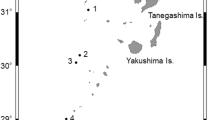Abstract
The fate of bacteria in the food of a common freshwater invertebrate has been studied both in controlled laboratory experiments and in a stream sediment. The animal chosen was the larva of the burrowing mayfly,Ephemera danica. It ingested all available bacteria nonselectively. More bacteria were found associated with the hindgut than with the mesenteron despite continuous plug flow of food through the alimentary canal. Species of bacteria were affected in different ways.Aeromonas hydrophila andCitrobacter freundii were both digested, the former selectively.Flavobacterium sp. and other unidentified species appeared to attach to the hindgut wall. Digestion of bacteria was not due to a sudden change in pH.
Similar content being viewed by others
References
Allen DA, Austin B, Colwell RR (1983) Numerical taxonomy of bacterial isolates associated with a freshwater fishery. J Gen Microbiol 129:2043–2062
Anderson JM, Rayner ADM, Walton DWH (1984) Invertebrate and microbial interactions. Cambridge University Press
Baker JH (1981) Growth rates of bacteria in rivers. Rep Freshwat Biol Ass 49:57–62
Baker JH, Bradnam LA (1976) The role of bacteria in the nutrition of aquatic invertebrates. Oecologia 24:95–104
Barlocher F, Kendrick B (1975) Leaf-conditioning by microorganisms. Oecologia 20:359–362
Bignell DE (1984) The arthropod gut as an environment for microorganisms. In: Anderson JM, Rayner ADM, Walton DWH (eds) Invertebrate and microbial interactions. Cambridge University Press, pp 205–227
Borsheim KY (1984) Clearance rates of bacteria-sized particles by freshwater ciliates measured with monodisperse fluorescent latex beads. Oecologia 63:286–288
Calow P (1974) Evidence for bacterial feeding inPlanorbis contortus Linn. (Gastropoda: Pulmonata). Proc Malac Soc London 41:145–156
Crisp DT, Gledhill T (1970) A quantitative description of the recovery of the fauna in a muddy reach of a mill stream in southern England after draining and dredging. Arch Hydrobiol 67: 502–541
Dadd RH (1975) Alkalinity within the midgut of mosquito larvae with alkaline-active digestive enzymes. J Insect Physiol 21:1845–1853
Drew RAI, Courtice AC, Teakle DS (1983) Bacteria as a natural source of food for adult fruit flies (Diptera:Tephritidae). Oecologia 60:279–284
Findlay S, Tenore K (1982) Nitrogen source for a detritivore: detritus substrate versus associated microbes. Science 218:371–373
Fry JC (1982) Interactions between bacteria and benthic invertebrates. In: Nedwell DB, Brown CM (eds) Sediment microbiology. Academic Press, London, pp 171–201
Gelder SR (1984) Diet and histopathology of the alimentary canal ofLumbricillus lineatus (Oligochaeta:Enchytraeidae). Hydrobiologia 115:71–81
King EO, Ward MK, Raney DE (1954) Two simple media for the demonstration of pyocyanin and fluorescin. J Lab Clin Med 44:301–307
Klug MJ, Kotarski S (1980) Bacteria associated with the gut tract of larval stages of the aquatic craneflyTipula abdominalis (Diptera:Tipulidae). Appl Environ Microbiol 40:408–416
Ladle M, Bass JAB, Jenkins WR (1972) Studies on production and food consumption by the larval Simuliidae (Diptera) of a chalk stream. Hydrobiologia 39:429–448
Mann RHK, Orr DR (1969) A preliminary study of the feeding relationships of fish in a hard-water and a soft-water stream in southern England. J Fish Biol 1:31–44
Martin MM, Kukor JJ (1984) Role of mycophagy and bacteriophagy in invertebrate nutrition. In: Klug MJ, Reddy CA (eds) Current perspectives in microbial ecology. American Society for Microbiology, Washington, DC, pp 257–263
Newell RC, Field JG (1983) The contribution of bacteria and detritus to carbon and nitrogen flow in a benthic community. Mar Biol Letters 4:23–36
Otto C, Svensson BS (1981) A comparison between food, feeding and growth of two mayflies,Ephemera danica andSiphlonurus aestivalis (Ephemeroptera), in a South Swedish stream. Arch Hydrobiol 91:341–350
Staples DG, Fry JC (1973) A medium for counting aquatic heterotrophic bacteria in polluted and unpolluted waters. J Appl Bacteriol 36:179–181
Wavre M, Brinkhurst RO (1971) Interactions between some tubificid oligochaetes and bacteria found in the sediments of Toronto Harbour, Ontario. J Fish Res Bd Can 28:335–341
Wotton RS (1980) Bacteria as food for blackfly larvae (Diptera:Simuliidae) in a lake outlet in Finland. Ann Zool Fennici 17:127–130
Wright JF, Hiley PD, Berrie AD (1981) A 9-year study of the life cycle ofEphemera danica Mull (Ephemeridae:Ephemeroptera) in the River Lambourn, England. Ecol Entomol 6: 321–331
Author information
Authors and Affiliations
Rights and permissions
About this article
Cite this article
Austin, D.A., Baker, J.H. Fate of bacteria ingested by larvae of the freshwater mayfly,Ephemera danica . Microb Ecol 15, 323–332 (1988). https://doi.org/10.1007/BF02012645
Issue Date:
DOI: https://doi.org/10.1007/BF02012645




